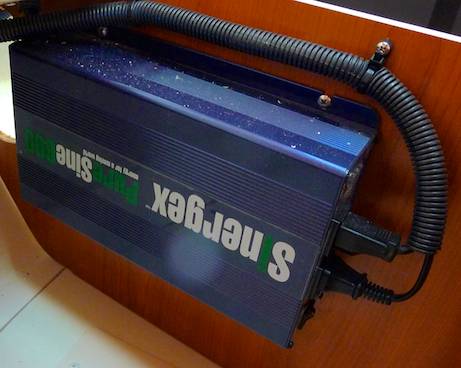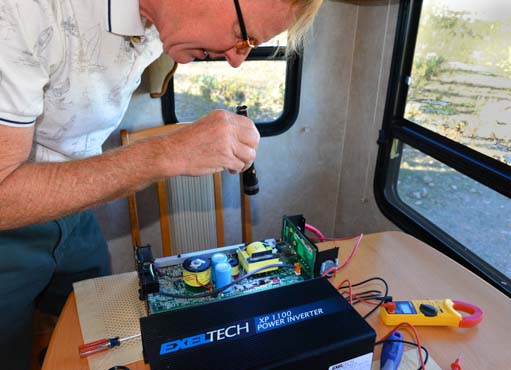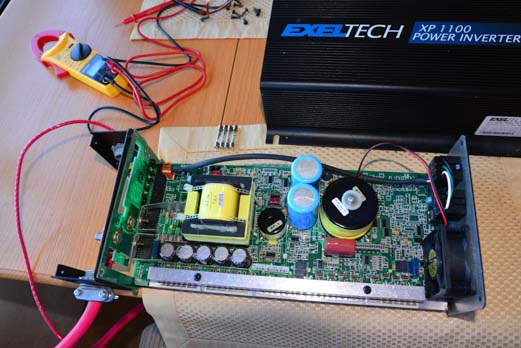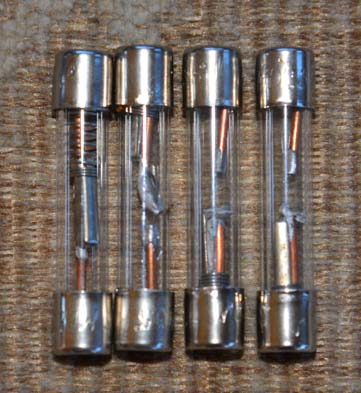Living totally off the grid on battery power in an RV or sailboat requires a good sized inverter to power the AC appliances like TVs, laptops, microwave, camera and cell phone chargers, hair dryers and vacuum cleaner.
But what is “good sized?” How much is too much — or not enough? What happens if you go over the limit? A recent mishap when we first returned to living in our trailer a few months ago sent us back to the basics and reminded us about limits, living skinny and living large while boondocking and living on a small inverter.

Our Exeltech XP 1100 watt pure sine wave inverter lives in the
fifth wheel basement.
Figuring out the math behind the theory — the amps, volts, watts and conversions between them — and doing that for each appliance while guessing how much time each one will be used every day is downright daunting.
What’s worse — for people like I once was who are dealing with this stuff for the first time when they contemplate full-timing — just the terms “inverter,” “converter,” and “inverter/charger” leave us scratching our heads in bewilderment. Techie phrases like “modified sine wave” and “pure sine wave” made my head spin when we first started out.
If that is the case for you too, have a look at our multi-part Solar Power Tutorial series where those terms (and many more) are explained in plain words.
As for inverter capacity, it is given in watts, and after living on several different sized inverters and inverter/chargers for almost seven years in two trailers and a sailboat, we have gotten a pretty good feel for what our moveable household of two people requires. But that doesn’t mean we are immune to slipping up!
When we bought our full-time fifth wheel trailer in 2008, like most trailers, it did not have a factory installed inverter. It had a 55 watt converter, and that was it. (Most motorhomes have a factory installed inverter/charger that is wired to the AC outlets instead of a converter.) So, we installed a pure sine wave Exeltech XP 1100 watt inverter.
This is a top quality inverter that is built to such high standards that it can run very sensitive medical equipment off the grid. Exeltech inverters are used on the International Space Station to provide AC power to both the American and Russian sides of the station!

This 600 watt pure sine wave inverter powered almost all
of our activities on the boat.
We chose that size because there was a huge increase in pure sine wave inverter prices once you got over about 1100 watts, and we had no single appliance on board that required more than that. (In 2014 prices, the XP1100 inverter is ~$600 while the XP2000 inverter is ~$1,300).
The trailer’s microwave is 900 watts, and everything else we use (except the air conditioning which requires a generator anyways) is much less than that. As long as we used only one big appliance at a time, all would be well.
The only real conflict that ever came up was when we used the microwave. We had to be sure the TV was off and the laptops were running on battery power for the few minutes we used the microwave. No big deal.
The sailboat we bought and moved aboard a few years after the trailer came with two factory installed inverters: a 2500 watt Xantrex Freedom 25 modified sine wave inverter/charger and Sinergex 600 watt pure sine wave inverter. The big inverter/charger was wired to all the AC outlets on the boat. However, the little 600 watt pure sine wave inverter had been installed exclusively for the entertainment system: the two AC outlets on the inverter had two ordinary extension cords that went directly to the TV and the Bose 3-2-1 surround sound system. This little inverter was independent of the boat’s AC wiring system.

The big modified sine wave Freedom 25 2500 watt inverter
powered the microwave and vacuum.
Because we had used a pure sine wave inverter in our trailer for a few years (and liked the idea of feeding our expensive computers a good quality signal), and because we assumed the big Xantrex inverter/charger would use a fair bit of power just to run in a “no load” state, we decided to rearrange the extension cords on the small pure sine wave inverter and use it as our primary inverter instead, running our laptops and charging up all our small appliances on it.
So, effectively, the only time we ever turned on the Xantrex inverter/charger was to use the boat’s 500 watt microwave that the factory had wired into the AC system, and to use our little dirt devil vacuum cleaner. Everything else — 22″ LED TV, 13″ MacBook laptops, cameras, portable GPS/VHF radio, GMRS walkie/talkie radios, toothbrush, etc. — got plugged into a power strip coming from the 600 watt pure sine wave inverter’s AC connector.

Mark inspects the Exeltech inverter
This worked really well for us for the 3.5 years we lived off the grid on the boat.
However, when we moved back into our trailer, we were still living in the mindset we’d had on the boat, which made us careless with the microwave. Whereas, on the boat, the 500 watt microwave was on a very big standalone inverter and we could use it without thinking, in the trailer, our 900 watt microwave shares the 1100 watt pure sine wave inverter with everything else on board.
One day, shortly after we moved back into the trailer, Mark popped some potatoes into the microwave for a few minutes. We were deep in conversation as he puttered around the kitchen and I messed around with photos on my laptop.
I thought it was odd when I noticed the charging light on my laptop go out, and he thought it was odd when he went to hit the button on the microwave for the next round of potato-cooking to find that none of the buttons on the microwave worked.
What the heck?

Well, at least nothing is visibly smoking!
We checked the usual things, and then went outside and around to the basement to see what the inverter was up to. Eventually, we realized that the inverter had just died.
Yikes!! This little black box is our life blood! And it would be a pricey devil to replace.
After a rather solemn dinner with almost-cooked potatos, Mark removed the inverter from the basement and opened it up to have a look inside.
Ouch. All four slow-blow fuses had blown. But thank heavens the rest of it was fully intact and there were no charred marks or burnt looking things anywhere.
The trailer repair gods were definitely smiling on us. We called Exeltech the next day to find out the fuse sizes (there were no sizes printed or etched on the blown fuses), and they were kind enough to put a few sets of fuses in the mail for us (free of charge!) to replace the four dead ones and to give us some spares in case of future mess-ups!

Wait, what’s up with the four “slow blow” fuses?
However, we had a five day wait until the replacement fuses arrived. It turns out that the size of these things is unique (35 amp slow blow). A sweep of the local auto parts stores turned up a few 30 amp slow blow fuses, which Exeltech said would work in a pinch, but Mark didn’t want to do the repair twice.
We liked our boondocking spot and didn’t feel like moving just to get electrical hookups, so, for the next five days we lived on a 350 watt modified sine wave inverter.
Sound crazy? Well, it CAN be done! We didn’t have to sacrifice too much. We just had to pay attention.
We aren’t big TV watchers unless the Olympics or Tour de France is on, but we use our two laptops for hours every day.
In the good old days of 2007, this little inverter of ours could power our white 13″ MacBook without a hitch, no matter what application we ran or how discharged the laptop was.

All four “slow blow” 35 amp fuses are blown
However, we soon discovered that today’s 13″ MacBook Pro’s (2011 and 2012 vintage, non-retina display) — and today’s software (2014 vintage) — all use a lot more power. Plus, we now have two laptops instead of one, which is more than the 350 watt inverter can handle. So, we had to devise a sharing scheme.
There are a few tricks to this.
The power required to charge a laptop varies depending on the laptop’s state of charge and the way in which it is being used:
- A laptop that has discharged batteries (nearly dead) requires more power to get charged up than one that’s 90% charged already.
- A laptop in use, especially if it is running disk-access intensive programs (like photo manipulation software), requires more power to charge than one running something tiny like a plain text editor (think Mac TextEdit or Windows Notepad).
- A sleeping laptop requires less power to charge than one that is in use
- A laptop that is completely shut down requires the least power of all to charge
I don’t have any firm numbers, but my hunch numbers are that it takes about 5-10 times more power to charge a laptop that is nearly discharged and is humming away on a bunch of really big photo manipulation programs (or moving lots of files around on disk) than it does to charge a laptop that is near full charge already, is shut down and is simply plugged into AC power.
With all these things in mind — and since our laptop use was our biggest power use in the trailer (we didn’t even try running our 26″ TV with surround sound on the 350 watt inverter) — this was our daily strategy:

This 7-year-old 350 watt modified sine wave inverter powered our lives for five days.
First thing in the morning, we would run the laptops from their own internal batteries until they were about 50% discharged (about an hour or two). If we weren’t done on the computers at that point, one of us would connect to the little inverter while the other continued on battery power.
After an hour or so, we would usually want to get outdoors. We would turn both laptops off and connect the most discharged on to the inverter to get charged up.
We’d return home later and either begin charging the other laptop up, or, if we both wanted to get back on our computers, we would alternate use of the inverter and go through the cycle again.
As for the Exeltech XP1100 inverter repair, as soon as we got the replacement fuses, Mark popped them into the inverter, installed it back in its home in the basement, and life was good and AC power was abundant in our home once again.

We were in a good spot. Why leave if we could make things work
for a while with a small inverter?
What did we learn from all this?
We can live simply when we need to!
Also, I’m really glad I asked the NuWa factory to install a cigarette lighter style DC outlet in the living room part of our trailer behind the TV (it came with one in the bedroom already). This makes it easy to use a small portable inverter in a pinch. In all honesty, I had questioned my sanity in asking the factory for this upgrade until this episode!
Then — on our next trailer (not that we’re getting a new one, but it’s always nice to think about that dreamy “next one”) — we will get a bigger inverter. There is nothing wrong with 1100 watts, as long as we think for a moment before flipping the switch on the microwave. However, in the next installation, we will be much more willing to spend double to get Exeltech’s 2000 watt pure sine wave inverter instead of their 1100 watt version. A bigger inverter will also allow us to use our Vita-Mix (1600 watts) which has been waiting in storage until we finish this crazy off-the-grid traveling lifestyle (which isn’t happening any time soon!).
Lastly… we learned that the Exeltech XP1100 inverter is well protected from absent-minded users with four wonderfully precious slow blow fuses. Very fortunately for me, it was an easy fix for Mark to do. But it seems that it is a fix that anyone who dares open the inverter case could accomplish. They were inline buss fuses and they didn’t even require a fuse puller — just a screwdriver to lift them out.
Learn more at our page: RV Electrical Power Overhual: New Batteries, Inverter and Converter
Related posts:
- RV and Marine Solar Power – Index of articles about Solar Power for RVs and boats
- RV and Marine Battery Charging Basics – Index of articles about RV and marine batteries
- RV and Marine Batteries – How to charge batteries by converter, inverter/charger, engine alternator and/or solar charger
- Boondocking Tips – How to Live Off the Grid in an RV
Subscribe
Never miss a post — it’s free!
Our most recent posts:
- How to Install Starlink Gen 3 in an RV? Use the Speedmount! 08/07/25
- Escape to Paradise – Rocky Mountain Magic! 08/01/25
- Is Forest River a Good RV? Well Built? Here’s Our Experience 06/20/25
- Sunset Crater Nat’l Monument – Lava & Camels at Bonito CG! 06/06/25
- 2024 Alpha Wolf 17CB Trailer – Our Goldilocks RV! 04/25/25
